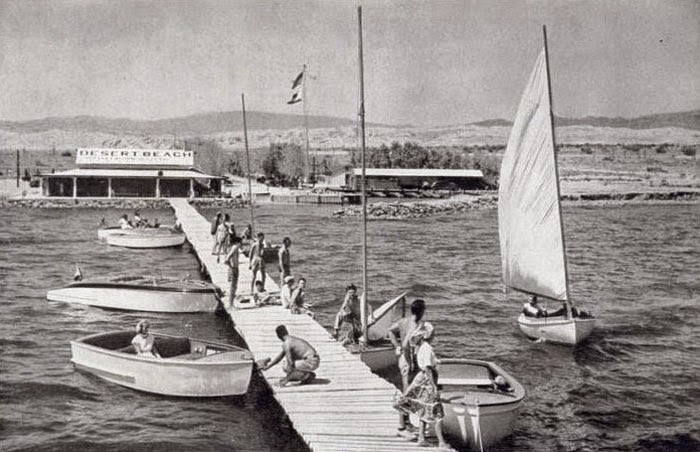Look at the aerial photograph of the eastern side of the Salton Sea. Bombay Beach is the rectangle in the center right. It is only about an hour drive from Palm Springs. This was a semi-trendy resort in the 1940s, but fish kills and environmental degradation of the Salton Sea largely killed the town. Once upon a time, Hollywood celebrities came to the Salton Sea to water ski and enjoy the winter sunshine. Not any more.
The mental_floss web page is less charitable
"It's a 10-by-10-block square of squat houses and mobile homes that was somebody's idea of paradise back when the town was incorporated in 1929. A beachy getaway 150 miles from the Pacific, it was supposed to be Palm Springs with water -- but decades of hyper-saline farm runoff and other problems turned the sea into a nightmare; plagued by fish and bird die-offs and outbreaks of botulism that leave its banks littered with corpses and its beaches smelling like hell, all but the hardiest tourists and investors had fled the scene by the late 60s. Even worse, the Salton began to overflow its banks, flooding the bottom part of town repeatedly. The remains of dozens of trailers and houses that couldn't be saved still sit rotting, half-buried in salty mud, along what used to be the town's most prized few blocks of real estate."Even the slate.com called it a "skeleton-filled wasteland." The setting attracts visitors interested in the post-apocalypse scenery. It would be a great setting for a zombie movie. There is a 2011 documentary named, "Bombay Beach," with music by Bob Dylan???
Drive on into town on Avenue A after turning off from California Hwy 111. Oh oh, it already looks like a place for urban decay photography.
The view north is a bit bleak.
But there is a shop and mailboxes, so there are some residents still here.
The surrounding blocks are also a bit (just a bit) bleak.
A road leads out past the levee to the lakefront. Was this a parking lot for beach-goers?
The lakefront is really rough, just scrap from former trailers and cottages.
Hmmm, someone was buried alive...
The beach is somewhat of a mess. The pilings are coated with salt, and the beach sediment consists of pulverized fish bones.
Back in town, Fifth Street is the waterfront esplanade (all right, the levee view esplanade). The graffiti is more interesting than the view.
On Avenue G, someone collected classic Volkswagen Beetles. At least they won't rust while awaiting concours restoration.
Not all is lost. Head east into the hills, and there are a number of modest resorts that attract Canadian visitors in the winter. This is Bashford's Hot Mineral Spa in Niland. The hot spring water flows into pools, where you can sit and absorb the mineral salts. If you are soaking at dusk, you see the swallows and bats swooping about and catching insects. It is very relaxing.
2014 Update
This is a late-1940s photograph from Desert Beach, from the Salton Sea Museum. The caption reads:
Skippers sail trim yachts, not subs, 40 fathoms below the Pacific on California's Salton Sea.
Desert Beach Yacht Club, 241 feet below sea level, welcomed the flyers with burning sands, 95 degree water and warm hospitality. A member of the American Power Squadron, the club holds speedboat races each fall. buoyancy of the salt-packed water makes for record-breaking runs.
Please click the link for a black and white version of Bombay Beach.
The aerial photograph was taken my my friend, Bill Birkemeier, from InTheLens.com. My daughter brought me to this great site (she knows my photographic interests). The ground-level photographs were taken with a Fuji X-E1 digital camera, with RAW files processed with Adobe Camera Raw and DxO Filmpack 3. The zombie-like atmosphere inspired me to experiment with color. The green-tone color frames were created by the cross-process emulation (i.e., E6 film processed in C41 chemicals). The red Volkswagen was faded blue, but with the Kodachrome intensity slider moved to 100%, the colors reversed. Rather cool.








-K25_resize.JPG)

























































